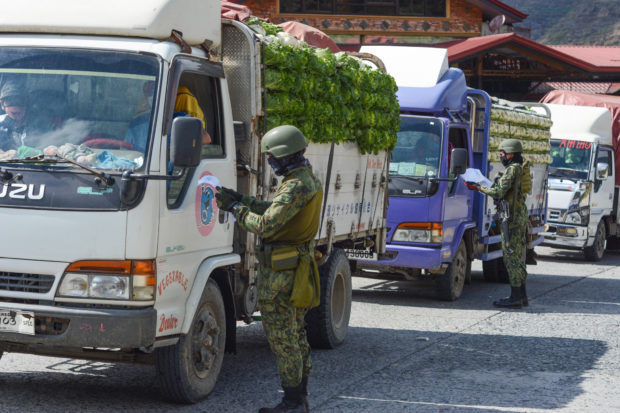
UNDUE DELAY Trucks laden with vegetables go through several checkpoints before they are allowed to deliver goods to markets in Metro Manila. —KARLSTON LAPNITEN
The government on Monday would begin the implementation of the new “RapidPass” system to speed up vehicle and personnel inspections at checkpoints and limit contact between those who are exempted from quarantine and the authorities manning checkpoints.
This is to further contain the spread of the new coronavirus disease (COVID-19), which primarily created the need for a Luzon-wide lockdown and an enhanced community quarantine, while at the same time ensuring the unhampered movement of essential items and services.
Hasten movement
In a press conference with the Inter-Agency Task Force (IATF) on Emerging Infectious Diseases on Friday, Cabinet officials together with Developers Connect Inc. (DevCon) founder Winston Damarillo, said the technology would be used to hasten the movement of front-liners, which includes medical workers, cargo drivers and suppliers, and other workers deemed “essential” by the IATF.
The technology’s creation was commissioned by the Department of Science and Technology in partnership with nonprofit organization DevCon—a community of Filipino developers and information technology professionals from all over the country.
Through the website www.RapidPass.ph, individuals may register and secure a QR code and a control number, which may be printed and posted on vehicles or may be shown to a checkpoint personnel through a smartphone.
‘Scan and Go’
Cabinet Secretary Karlo Nograles made clear that the RapidPass would not be required of everyone, but holders may pass through a “Scan and Go” lane which would be faster and more convenient.
“The RapidPass will be available to everyone but it will not be required. They can still choose to present IDs or documents. But this option will be available to those who want to pass through our checkpoints faster and want to reduce contact with others at checkpoints,” Nograles said.
This is to prevent the heavy traffic and bottlenecks at checkpoints, and avoid delays in the delivery of authorized services.